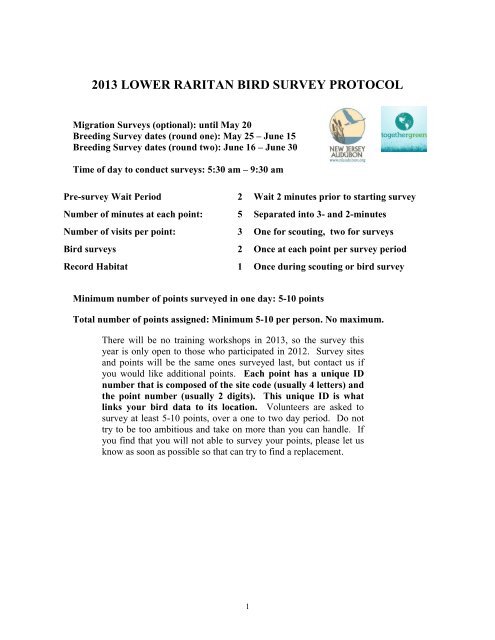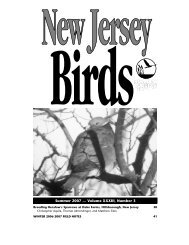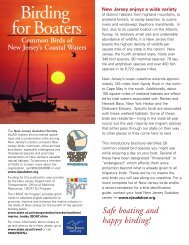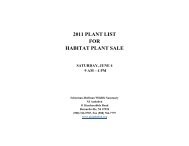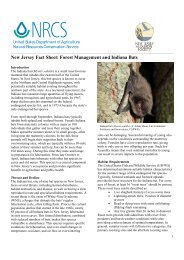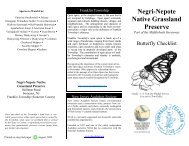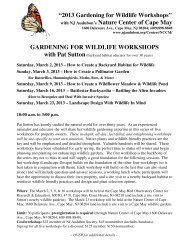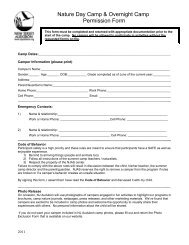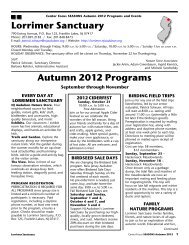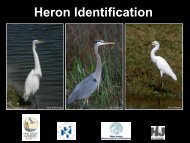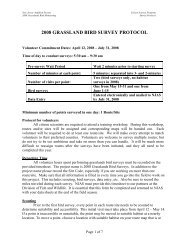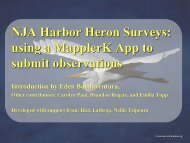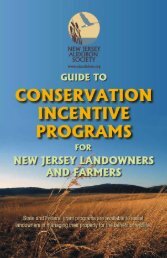Grassland Bird Survey Protocol - New Jersey Audubon Society
Grassland Bird Survey Protocol - New Jersey Audubon Society
Grassland Bird Survey Protocol - New Jersey Audubon Society
Create successful ePaper yourself
Turn your PDF publications into a flip-book with our unique Google optimized e-Paper software.
2013 LOWER RARITAN BIRD SURVEY PROTOCOL<br />
Migration <strong>Survey</strong>s (optional): until May 20<br />
Breeding <strong>Survey</strong> dates (round one): May 25 – June 15<br />
Breeding <strong>Survey</strong> dates (round two): June 16 – June 30<br />
Time of day to conduct surveys: 5:30 am – 9:30 am<br />
Pre-survey Wait Period 2 Wait 2 minutes prior to starting survey<br />
Number of minutes at each point: 5 Separated into 3- and 2-minutes<br />
Number of visits per point: 3 One for scouting, two for surveys<br />
<strong>Bird</strong> surveys 2 Once at each point per survey period<br />
Record Habitat 1 Once during scouting or bird survey<br />
Minimum number of points surveyed in one day: 5-10 points<br />
Total number of points assigned: Minimum 5-10 per person. No maximum.<br />
There will be no training workshops in 2013, so the survey this<br />
year is only open to those who participated in 2012. <strong>Survey</strong> sites<br />
and points will be the same ones surveyed last, but contact us if<br />
you would like additional points. Each point has a unique ID<br />
number that is composed of the site code (usually 4 letters) and<br />
the point number (usually 2 digits). This unique ID is what<br />
links your bird data to its location. Volunteers are asked to<br />
survey at least 5-10 points, over a one to two day period. Do not<br />
try to be too ambitious and take on more than you can handle. If<br />
you find that you will not able to survey your points, please let us<br />
know as soon as possible so that can try to find a replacement.<br />
1
2013 Lower Raritan bird survey<br />
Developed by Nellie Tsipoura and Mike Allen, <strong>New</strong> <strong>Jersey</strong> <strong>Audubon</strong> <strong>Society</strong><br />
Introduction<br />
The Raritan River is <strong>New</strong> <strong>Jersey</strong>’s largest river and is located entirely within our state’s<br />
borders. Including the watershed, the Raritan River Basin encompasses more than 1,100<br />
square miles (262,941 acres). Its waters are used for drinking, recreation, transportation<br />
and industry. Despite the environmental pressure to which they have been subjected, the<br />
Raritan River and Raritan Bay Estuary provide important wildlife habitats. From wetland<br />
and estuarine habitats that support osprey, night herons and black skimmers, riparian<br />
corridors that support nesting bald eagles, to upland grasslands sustaining grasshopper<br />
sparrows and bobolinks, thousands of acres within the watershed provide habitat critical<br />
to the continued survival of a diverse array of threatened and endangered species that is<br />
unrivaled in <strong>New</strong> <strong>Jersey</strong>. Threats to this system include extreme pressure from<br />
commercial and residential developments. In addition, industrial development has<br />
resulted in contamination of parts of the river and associated wetlands for decades.<br />
However, large sprawling industrial complexes also include some of the last remaining<br />
undeveloped habitats in this heavily populated watershed.<br />
<strong>New</strong> <strong>Jersey</strong> <strong>Audubon</strong> was been involved in surveys of urban habitats for birds for the<br />
past 30 years. Richard Kane, former Vice-president of Conservation, began conducting<br />
surveys and reporting on the Meadowland's avifauna in 1975. In 1991 Rich Kane headed<br />
up a team of NJAS staff that conducted the first year-long inventory of the Arthur Kill<br />
and Raritan. Much of what we currently know about the seasonal occurrences of avian<br />
species in the urban <strong>New</strong> <strong>Jersey</strong> wetlands is based on this work. More recently, the<br />
NJAS’s Research and Monitoring Department undertook and completed a two-year,<br />
systematic study of avian abundance and distribution in the Meadowlands 2004-2006),an<br />
avian study in the Gateway National Recreation Area (2006-2007), and a survey of the<br />
Lower Raritan (2009).<br />
Though this citizen science project we will continue and expand the 2009 surveys in<br />
Lower Raritan River to provide baseline information on bird use in the area. Results of<br />
this project will help set site acquisition priorities, and direct management and restoration<br />
activities related to reducing fragmentation and improving habitats for wildlife.<br />
Reporting Time<br />
All volunteer hours spent performing Lower Raritan bird surveys must be recorded on the<br />
provided timesheet. The project name is Lower Raritan <strong>Bird</strong> <strong>Survey</strong>s. In addition to the<br />
project name please record the Site Code, especially if you are working on more than one<br />
site. Make sure that all information is filled in every time you go into the field to work<br />
on this project. This includes scouting, habitat assessments, bird surveys, data entry, etc.<br />
2
Also be sure to record the miles traveled during each survey. NJAS must provide this<br />
timesheet to our funding partners. It is essential that this form be completed and returned<br />
to NJAS with your data sheets at the end of the field season. Thank you.<br />
Scouting<br />
Prior to the first bird survey, every point in each site needs to be scouted to determine<br />
suitability and accessibility. This initial visit must take place at any time before the<br />
surveys.<br />
Record habitat characteristics and dominant plant species at each point during this initial<br />
visit. Recording habitat is not meant to bog you down, it is a quick assessment of the<br />
dominant vegetative species, the habitat structure and habitat type. It should only take<br />
20 to 30 seconds at each point (see habitat protocol for further details).<br />
If a point is inaccessible, the point may be moved to a nearby location. To move a point,<br />
choose a location with suitable habitat on your route map that is at least 1000 feet or 300<br />
meters (straight distance) from any other point. Points should be relocated to the nearest<br />
suitable area of the same habitat type as the original point (forest, shrub scrub, open<br />
field, wetland.) When you find the new point location, draw an arrow on the route map<br />
from the old point location to the new one and indicate why it was moved (developed,<br />
inaccessible, etc). Make sure to mark the new location on the route map or the aerial<br />
map and record the GPS coordinates and the units (UTM, decimal degrees, etc.). If<br />
there are no other suitable locations that meet the criteria to move a point, then mark it<br />
on the map with an X and indicate why it was not surveyed (developed, inaccessible,<br />
etc.).<br />
PLEASE LET US KNOW (michael.allen@njaudubon.org) about any points that you<br />
move. If the area around the original point has been developed, please let us know<br />
immediately.<br />
<strong>Bird</strong> <strong>Survey</strong>s<br />
Make sure you are familiar with the songs of species likely to be seen during your<br />
surveys, and the points on identification. Some species are rather difficult to see through<br />
the vegetation or do not allow close approach for visual identification. We provided CDs<br />
of songs to all participants in the 2012 training workshops, and you are encouraged to<br />
keep practicing. We recommend you use a good field guide for visual identification.<br />
Each volunteer will be responsible for a minimum of 5-10 points. Each point is a predetermined<br />
location from which the observer conducts a survey.<br />
<strong>Survey</strong>s should not be conducted during rain. <strong>Survey</strong>s should also not be conducted<br />
during high winds (greater than 12mph {Beaufort 3}, which is enough to constantly<br />
move leaves or twigs and to extend a light flag.) <strong>Survey</strong>s will take place a half hour<br />
before to three hours after sunrise (approximately between 5:30 am and 9:00 am),<br />
during the breeding season. You will survey each point twice during the breeding<br />
3
season: once between May 25 th and June 15 th , and once between June 16 th and June 30 th .<br />
Once the observer arrives at the survey point wait 2 minutes before beginning the count.<br />
This enables the observer to prepare for the count and allows the birds to calm down and<br />
return to normal activity. During the survey the observer stands at the point for 5 minutes<br />
and records on the data sheet all grassland bird species seen or heard. This 5-minute<br />
period is divided into two periods; a 3- and a 2-minute period. The observer records the<br />
species and number of birds seen or heard during the first 3 minutes separately from<br />
those encountered during the next 2 minutes. Record all birds as less than 100 meters or<br />
greater than 100 meters away from the survey point on the data sheet. Do not count<br />
longer than five minutes. Do not exceed the 5-minute time limit because you are sure a<br />
certain "good bird" is there and not calling -- it will probably be recorded some other<br />
year, and valid negative data are as important as positive data in this survey. Species<br />
recorded that are not found on the form should be added at the bottom. If you observe<br />
any birds before or after the 5-minute survey, write it down in the margin or blank<br />
spaces on the bottom of the datasheet with a “before” or “after” next to it.<br />
One and only one observer should conduct the count. Counting should be done from<br />
outside the car from a stationary point. Absolutely no method of coaxing birds should be<br />
used during the 5-minute survey period. This means no "pishing", tape playbacks or any<br />
other method of enticing a bird to sing or call or make itself visible. It is crucial that all<br />
surveys be done consistently. Target birds observed between stops should not be counted,<br />
but may be noted in the margin of the route map with a line indicating the location of the<br />
species. Such birds are of interest, but do not spend extra time pursuing them, as it is<br />
important to finish within the time limit; bird activity changes drastically after this time.<br />
Be sure you record the survey site code, survey point number, observer,<br />
recorder (if applicable), date, start time and weather conditions on every<br />
datasheet.<br />
Each survey will be undertaken singly or by two people. We prefer single observers<br />
because we do not want the volunteer’s ability to concentrate on the birds to be<br />
compromised by the presence of another person. However, if you want to undertake the<br />
surveys with your birding partner, please take all precautions to avoid being distracted.<br />
Remember, only one person should be the primary observer. The second person can act<br />
as the recorder in this situation. If there are two observers, the primary observer says<br />
what she/he sees or hears to the recorder in a quiet voice and the recorder repeats back<br />
what she/he heard as the data are recorded. Only the birds seen and heard by the primary<br />
observer get recorded on the forms. If the recorder sees or hears a target species before<br />
or after the 5-minute survey, write it down in the margin or blank spaces on the bottom<br />
of the datasheet with a statement that this is a recorder observation.<br />
**Note on Counting the Same <strong>Bird</strong>: The same bird seen/heard in the 3-<br />
minute portion of the survey, then seen/heard again in the 2-minute<br />
portion is ONLY recorded in the 3-minute period as this is definitely a<br />
single individual. If you are sure that a bird observed in the 2-minute<br />
period is different from the one observed in the 3-minute period, by all<br />
4
means record it as a different individual in the 2-minute time slot.<br />
Noting on the data sheet that you were sure two different birds were<br />
observed is good to do.<br />
In all situations, avoid biasing the data by disturbing the birds. Walk out of your<br />
car quietly, approach the survey point cautiously, avoid unnecessary movements and try<br />
to blend in as much as possible.<br />
The method by which the bird was observed can be recorded as S (seen), H (heard), or<br />
SH (both seen and heard). Make sure you record flyovers (birds flying over, not through<br />
habitat).<br />
If females or juveniles are seen please note that information. Unless otherwise noted, we<br />
will assume that all detections are of singing males.<br />
Habitat <strong>Survey</strong>s<br />
At each point please describe general habitat characteristics of the area. Appendix I.<br />
(below) is a listing of the broad habitat categories. You can use the codes and record in<br />
the front of your data sheet, or circle the categories in the back of the data sheet.<br />
Circle the habitat class (upland or wetland) and habitat type (Urban; Barren land;<br />
Agricultural; Natural grassland; Scrub/shrub; Forest; Open water; Mudflat; Other). Feel<br />
free to add any other information on habitat in the comments section.<br />
Data Entry<br />
All observers will have access to NJAS’s online data entry website. Contact Nellie<br />
Tsipoura or Mike Allen for more instructions on how to use the data entry system.<br />
The system may not be set up yet. Go to<br />
http://www.njaudubon.org/Raritan2013/Login.aspx. At the bottom of the page you can<br />
click on Enter Data. This will send you to a new page. Click on the link that allows you<br />
to Enter Lower Raritan survey data. At the bottom of the page click Create a <strong>New</strong><br />
Account. Enter a User ID for yourself. Enter a password (at least 5 characters) and<br />
confirm that password. Enter your name, phone number and email address in the<br />
appropriate box. Nellie Tsipoura will provide Site Password. A page will open that asks<br />
you for the new User ID and password. Type them in, hit enter and you should be<br />
relocated to the data entry page. If you have any technical difficulties with this please let<br />
me know immediately so we can correct the problem.<br />
5
Once you have entered all of your data mail your hard copies to:<br />
Nellie Tsipoura<br />
<strong>New</strong> <strong>Jersey</strong> <strong>Audubon</strong> <strong>Society</strong><br />
Scherman-Hoffman Wildlife Sanctuary<br />
11 Hardscrabble Road<br />
P.O. Box 693<br />
Bernardsville, NJ 07924<br />
Thank you for your assistance and good luck with all of your surveys.<br />
PLEASE MAIL ALL DATA SHEETS BY August 1, 2013<br />
6
Appendix I.<br />
Weather conditions (from Breeding <strong>Bird</strong> <strong>Survey</strong>)<br />
Beaufort<br />
Wind Speed in<br />
Scale miles per hr. Indicators of Wind Speed<br />
0 Less than 1 Smoke rises vertically<br />
1 1 to 3 Wind direction shown by smoke drift<br />
2 4 to 7 Wind felt on face; leaves rustle<br />
3 8 to 12 Leaves, small twigs in constant motion;<br />
light flag extended<br />
4 13 to 18 Raises dust and loose paper; small<br />
branches are moved<br />
5 9 to 24 Small trees in leaf sway; crested<br />
wavelets on inland waters<br />
SKY CONDITION CODES:<br />
0 Clear or a few clouds<br />
1 Partly cloudy (scattered) or variable sky<br />
2 Cloudy (broken) or overcast<br />
4 Fog or smoke<br />
5 Drizzle<br />
7 Snow<br />
8 Showers<br />
Appendix II<br />
Equipment Checklist<br />
Clipboard Pencils<br />
Forms<br />
<strong>Bird</strong> count datasheet<br />
Habitat Category Form<br />
Route map<br />
Binoculars<br />
Watch with second hand (or timer)<br />
Thermometer (optional)<br />
7
Appendix III – 2012 Lower Raritan <strong>Survey</strong> Points<br />
8


